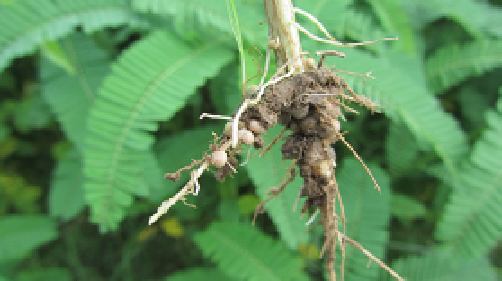Agriculture Reference
In-Depth Information
significant differences were observed in the water
content of the aerial parts, whereas this increased signif-
icantly in the roots. Ashraf
et al.
(2013) investigated
three mung bean (
V. radiata
) cultivars in response to salt
stress. They observed marked decreases in plant height,
shoot relative water content, photosynthetic pigments,
endogenous levels of K
+
and K
+
/Na
+
ratios, and elevated
levels of H
2
O
2
, MDA, Na
+
and Cl
−
. These parameters dif-
fered greatly depending on the cultivars. The most
tolerant cultivar (NCM-209) exhibited the smallest
decline in K
+
, K
+
/Na
+
ratio and photosynthetic pigments
as well as lower levels of H
2
O
2
and MDA. The variations
in the endogenous H
2
O
2
and MDA under salt stress were
modulated by the activities of the antioxidant enzymes,
which were greatly dependent on cultivars. Yield
reduction due to salt stress differed significantly among
the mung bean cultivars; because of its greater tolerance
the cultivar NCM-209 showed the highest yield. Rasool
et al.
(2013) studied the relative performance of eight
chickpea cultivars at different levels of salinity (25, 50,
75 and 100 mM NaCl). Salinity caused great reductions
in fresh and dry weights of root and shoot in dose-
dependent ways. The oxidative damage was also higher
in the plants exposed to salinity as measured by increased
levels of lipid peroxidation. Salinity also reduced the chl
content. Although salt stress increased the activities of
antioxidant enzymes in all cultivars, the salt-tolerant
genotypes (SKUA-06 and SKUA-07) showed higher
activities than others. Rasool
et al.
(2013) also grew bean
seedlings under different concentrations of salt (60, 120
and 240 mM NaCl) and observed that growth, osmotic
potential, chl content and protein content all substan-
tially decreased due to salt stress.
Figure 11.2
Root system of
Sesbania aculeata
containing
nodules, organs formed in leguminous plants that help to fix N
in soil. They are a product of successful interactions between
the host plant and the soil bacteria,
Rhizobium
spp.
greatly affected the yield and there was a highly negative
correlation between salt concentration and yield. The
effects of salt stress on growth and metabolism in
V. faba
was also studied by Qados (2011). Five lentil cultivars
varying in their salt tolerance were grown with seawater
irrigation (electrical conductivity (EC) 0.9-12 dS/m) by
Natsheh
et al.
(2012). They observed that seawater
of salinity 3 and 6 dS/m did not cause any negative
effects on germination and growth, whereas at higher
salinity (EC 12 dS/m) the germination rate was reduced
and the mean germination time was greater in all culti-
vars tested. Chickpea (
C. arietinum
) is highly sensitive to
salinity. Haileselasie and Teferii (2012) reported that
increased concentration of salt had a negative impact on
the germination and growth of chickpea by reducing its
germination, water uptake and length of root and shoot.
In a laboratory experiment, Ashagre
et al.
(2013) observed
the effect of different salt concentrations (50, 100, 150
and 200 mM NaCl) on germination and seedling vigour
of two chickpea cultivars, viz. Worku and Shasho.
Regardless of the salt concentration, salinity markedly
decreased the germination rate and seedling vigour of
chickpea. However, a higher germination percentage
was recorded in Shasho than in Worku, which indicated
its better tolerance to salinity. The dry weight and length
of radical and plumule were reduced due to salt stress in
dose-dependent ways, but the effects were less in salt-
tolerant Shasho than in Worku. In soybean, Queiroz
et al.
(2012) observed a drastic alteration in growth and
metabolism when plants were exposed to elevated levels
of salt. Soybean receiving 200 mM NaCl exhibited 34%
and 62% reductions in shoot length and fresh weight,
respectively. Interestingly, upon salt treatment no
11.3.2 Drought
Among the abiotic stresses, drought is the most complex
and devastating on a global scale, and has pronounced
adverse effects on the growth and development of crop
plants. Drought stress usually leads to reductions in crop
yield, which can result from many drought-induced
morphological, physiological and metabolic changes in
the plants (Hasanuzzaman & Fujita 2011; Hasanuzzaman
et al.,
2014a). Since drought is closely associated with
both plants and soil conditions, improving grain legume
productivity in drought-prone environments is consid-
ered not only in terms of increased grain yield, but also
as improvements to the physical, chemical and biological
characteristics of the soil (Subbarao
et al.,
1995). In fact

Search WWH ::

Custom Search